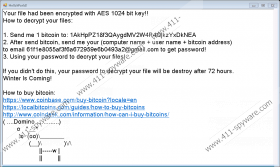Domino Ransomware Removal Guide
As Domino Ransomware is quite a prevalent infection these days, specialists at 411-spyware.com have decided to tell users more about it. First of all, you need to know that Domino Ransomware is a threat targeted at users’ personal files. If it ever enters your computer, you will no longer be allowed to open pictures, documents, music, and other valuable data you keep. All the files locked by this ransomware will have the .domino extension, which is why specialists have given the name Domino Ransomware to this threat. Only the names of the ransomware infections differ, but they all act very similarly, for example, Domino Ransomware will try to convince you to pay the ransom for the decryption password just like such well-known infections as Fantom Ransomware, Malevich Ransomware, and Sitaram108 Ransomware. To be frank, it locks all the files it finds stored on the computer to have a reason to ask users to pay money. The decryption password cyber criminals promise you to send after you make a payment is quite expensive. Therefore, we want you to carefully consider what to do. If you wish to hear what we think, you should know that, in our opinion, supporting cyber criminals is very silly.
Research has shown that Domino Ransomware not only locks all the files it finds on the system, but also places two new files named Help.exe and Helloworld.exe that are necessary for it to work properly in the directory %TEMP%. The major function of these files is to open the pop-up window with the ransom note after the encryption of personal files the ransomware finds on the infected computer. If you see such a message (see below), we can assure you that the ransomware infection is inside your computer:
Your file had been encrypted with AES 1024 bit key!!
How to decrypt your files:
1. Send me 1 bitcoin to: 1AkHpPZ18f3QAygdMV2W4R4QjkzYxDkNEA
2. After send bitcoin, send me your (computer name + user name + bitcoin address)
to email 61f1e8055af3f6a672959e6b0493a2@gmail.com to get password!
3. Using your password to decrypt your files!
If you didn't do this, your password to decrypt your file will be destroy after 72 hours.
Winter Is Coming!
How to buy bitcoin:
https://www.coinbase.com/buy-bitcoin?locale=en
https://localbitcoins.com/guides/how-to-buy-bitcoins
http://www.coindesk.com/information/how-can-i-buy-bitcoins/
( ....Domino .............)
o ^__^
o (oo)\_______
(__)\ )\/\
||-----w |
|| ||
The ransom note explains users what they have to do to unlock their files. As you can see, you are asked to pay 1 Bitcoin (approximately $575). It is very likely that cyber criminals will not give you the key to unlock files even if you transfer this amount of money, so you should keep the money to yourself. What you can do instead of paying money is to try to recover your files using the free software. Of course, there is no need to do that if you have copies of your files. Before you restore your files from a backup, remove Domino Ransomware fully because this threat might encrypt your new files again. We want that you know that it might be impossible to decrypt files using free tools because this infection uses the AES-1024 encryption method to lock files.
Domino Ransomware not only sneaks onto computers secretly and encrypts personal files it manages to find. Researchers at 411-spyware.com have also found out that this ransomware connects to the Internet without permission from time to time. We do not know exactly why it needs the Internet connection, but we suspect that it communicates with its command and control server. This means that it might be updated, or cyber criminals might place other malicious applications on your PC without your permission.
As ransomware infections are so prevalent these days, you might encounter a similar threat again if you are not careful. You need to know that ransomware infections are mainly distributed through spam emails, so you should ignore them all and keep your distance from them. As ransomware might find other ways to enter computers too, we suggest being extremely careful. First of all, you should download software from reliable sources only, check the software you are going to install before you actually do that, and, finally, it is a must to acquire the antimalware scanner, e.g. SpyHunter. Enable it and keep it like that to ensure the maximum protection.
You should follow our step-by-step removal guide to delete Domino Ransomware fully from the system. As you can see, you will have to remove two files that belong to this infection. Security specialists at 411-spyware.com say that you should not forget to locate and remove other threats from your PC too. Believe us; these threats might be inside your system too if Domino Ransomware has found a way to enter the computer.
Remove Domino Ransomware
- Open the Windows Explorer by tapping the Windows key + E.
- Copy and paste %TEMP% in the bar at the top. Tap Enter.
- Locate Help.exe and Helloworld.exe files.
- Remove both of them.
- Find the malicious file you have downloaded recently.
- Remove it.
Domino Ransomware Screenshots:


